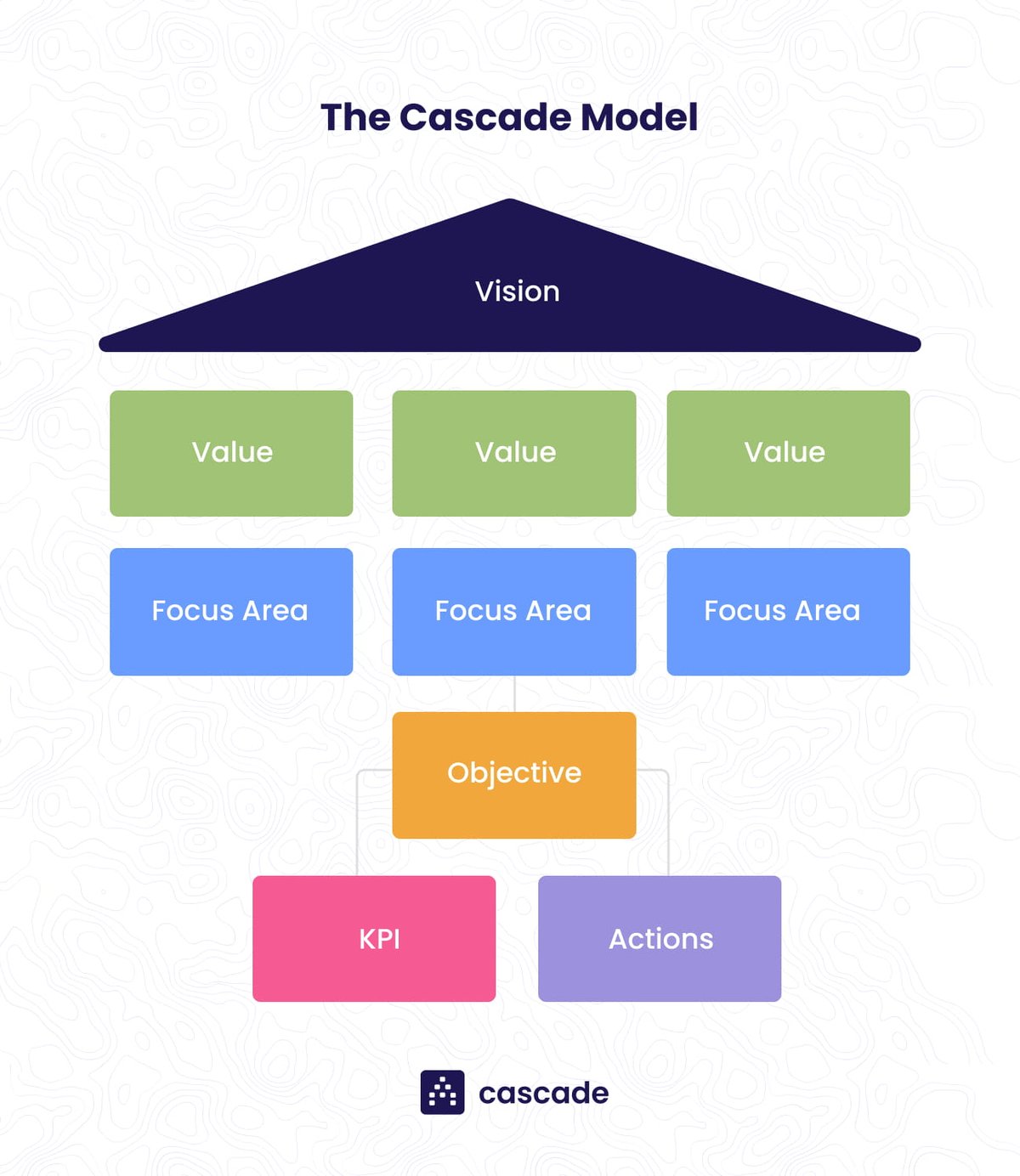In the world of startups, scaleups, and corporate innovation, strategy is meaningless without execution. Many ambitious entrepreneurs and professionals craft compelling visions but struggle to turn them into tangible progress. The Cascade Model offers a practical and structured framework that helps break down grand strategies into actionable steps. This article explores how the model works and how you can apply it to stay focused, aligned, and results-driven.

The Cascade Model is a strategic planning framework that connects high-level vision to daily execution. It breaks down strategy into six interconnected layers:
By working through these layers in sequence, you create a clear line of sight from long-term goals to the day-to-day tasks that move you forward. It’s a popular method for teams that need clarity, alignment, and agility—especially in fast-changing environments.
Source: Cascade Blog – Strategy Planning Models
A vision is your strategic north star. It captures what you ultimately want to achieve and defines your ideal future. It should be ambitious yet grounded, specific enough to guide decision-making but flexible enough to adapt as needed.
Examples of strong visions include:
Your vision should be easy to remember, emotionally resonant, and directionally clear. A strong vision not only motivates internally but also helps communicate externally what your organization stands for.
To craft a powerful vision, ask yourself:
A good vision is both a rallying cry and a filter for decision-making.
Values define how you pursue your vision. They form your ethical compass, shaping your culture and guiding everyday behavior. Unlike goals or objectives, values don’t change quarterly—they are enduring principles that help align decisions and actions.
Examples might include:
Your values should influence hiring, strategy, communication, and even partnerships. When values are deeply embedded, they create consistency across your organization—even during times of uncertainty or change.
To implement values effectively:
Organizations that live their values consistently outperform those that treat them as mere slogans.
Focus areas are strategic themes or priorities that sit between your vision and your objectives. They represent the pillars of your strategy—areas where you need to concentrate your time, resources, and energy.
Typical focus areas include:
Your focus areas should reflect what matters most over the next 6–12 months. Too many priorities dilute attention; too few might miss critical dimensions.
Limiting your focus areas to three to five is ideal. This balance ensures you cover core strategic domains without overwhelming your team. Review and revise focus areas quarterly to stay aligned with market and business changes.
Within each focus area, you define objectives—clear, measurable outcomes you want to achieve. Objectives break down your strategic priorities into actionable targets.
Use the SMART framework to ensure objectives are:
For each focus area, aim for three to five objectives. This provides enough direction without overwhelming your team or losing focus.
Example:
Make sure objectives are outcome-based, not task-based. “Increase MRR by 20%” is stronger than “Launch new pricing page,” because it focuses on impact rather than activity.
Source: Doran, G. T. (1981). There's a S.M.A.R.T. way to write management's goals and objectives. Management Review, 70(11), 35–36.
Objectives guide you, but KPIs (Key Performance Indicators) and actions move you forward.
Example:
KPIs make progress visible and help inform timely decisions. Ideally, they should be updated frequently (weekly or biweekly) and reviewed in team meetings. Every KPI should be assigned to an owner.
Actions, on the other hand, are your execution playbook. Without action, even the best strategy will stagnate. Actions should be broken down into manageable tasks, prioritized, and tracked.
Source: Parmenter, D. (2015). Key Performance Indicators: Developing, Implementing, and Using Winning KPIs. Wiley.
The strength of the Cascade Model lies in its ability to align everyone—from executives to individual contributors—around shared priorities. When implemented well:
Alignment increases ownership, reduces redundancy, and accelerates execution. It creates a shared language across departments and ensures that everyone rows in the same direction.
To ensure alignment:
Even strong strategic models can fall apart in execution. Watch out for these mistakes:
Mitigate these risks by building review cadences into your process. Quarterly strategy sessions, monthly KPI reviews, and weekly action check-ins can help keep things on track.
Strategy isn’t something you create once a year—it’s an ongoing cycle of prioritizing, executing, learning, and adjusting. The Cascade Model transforms strategy into a living, breathing system that evolves with your business.
Whether you're running a startup, scaling a team, or leading transformation in a larger organization, this model offers structure without rigidity. It gives you a framework to keep moving—even when circumstances shift.
The key takeaway? Strategy lives or dies in execution. And execution thrives with clarity, focus, and accountability.
Need help applying this framework to your own business or team?Let’s work together. Check out my profile on MentorCruise: mentorcruise.com/mentor/jimmyjaspers and book a session.
Disclaimer: This article is written in a personal capacity from my role as a mentor and entrepreneur.
Find out if MentorCruise is a good fit for you – fast, free, and no pressure.
Tell us about your goals
See how mentorship compares to other options
Preview your first month
